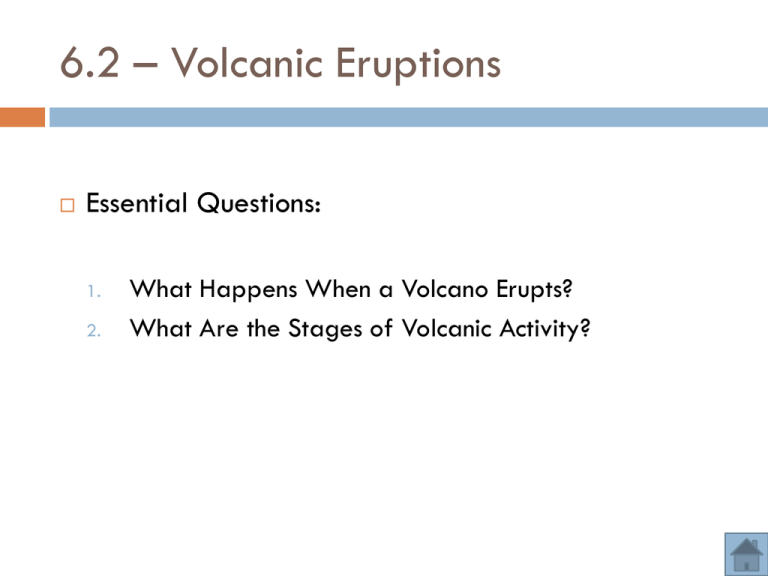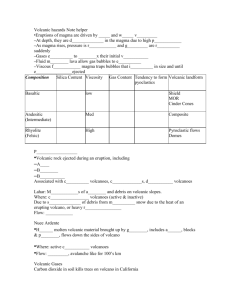Volcanic Eruption Notes
advertisement

6.2 – Volcanic Eruptions Essential Questions: 1. 2. What Happens When a Volcano Erupts? What Are the Stages of Volcanic Activity? How Does a Volcano Form? Magma, which is hotter and less dense than other rock in the mantle, rises through any cracks it finds. When the magma reaches the surface, a volcano can form. Ignore the numbers. Anatomy of a Volcano Magma chamber – A pocket of magma beneath the surface. Pipe – A long tube that extends from the magma chamber, up through the volcano, to Earth’s surface. Vent – Opening(s) in the volcano through which molten rock and gases escape. Crater – A bowl-shaped area that may form at the top of a volcano around a central vent. Lava flow – The spread of lava as it flows out the vent. Anatomy of a Volcano Central Vent Crater Lava Flow Side Vent Pipe Magma Chamber A Volcanic Eruption Just like a can of soda, magma contains trapped gases. As the magma reaches the surface, the pressure decreases and the gases expand. This produces huge forces! When a volcano erupts, the force of the expanding gases pushes magma from the magma chamber through the pipe until it flows or explodes out of the vent. A Volcanic Eruption (Sarychev as seen from the ISS) Russia Silica Silica (SiO2) is a material found in magma that helps determine its viscosity. Viscosity is a fluids natural resistance to flow. Types of Volcanic Eruptions Quiet Hot, low silica magma is thin and runny. Gases escape easily. Explosive High silica content. Magma is thick and sticky. Gases become trapped Photographed from space!!! Volcanic Tephra Tephra is the general term for volcanic ejecta. Ash – Less than .1 inch in diameter. Not good for breathing! Volcanic Tephra Tephra is the general term for volcanic ejecta. Lapilli Latin – Between .1 and 2.5 inches in diameter. for “little stones”. Volcanic Tephra Tephra is the general term for volcanic ejecta. Block – Larger than 2.5 inches. Also not good for your health. Volcanic Tephra Tephra is the general term for volcanic ejecta. Bombs – Molten fragments that harden in mid-air. Volcanic Hazards Lava flows. Volcanic Hazards Pyroclastic flows, which are fast moving clouds of ash, gas, and dust. Volcanic Hazards Toxic gases such as CO2, SO2, and H2S. Volcanic Hazards Lahars – Mudflows that result when snow melts. Stages of Volcanic Activity Anywhere from less than 10 years to more then 10,000,000 years. Active volcanoes are ones that are erupting or show signs of eruption in the near future. Dormant volcanoes may erupt in the future, but do not currently show signs. Extinct volcanoes are unlikely to ever erupt again. Eruption Precursors Ground movements measured by tiltmeters. Earthquakes measured by seismometers. Changes in heat output measured with thermometers. Volcanic gases detected by air analysis.








